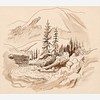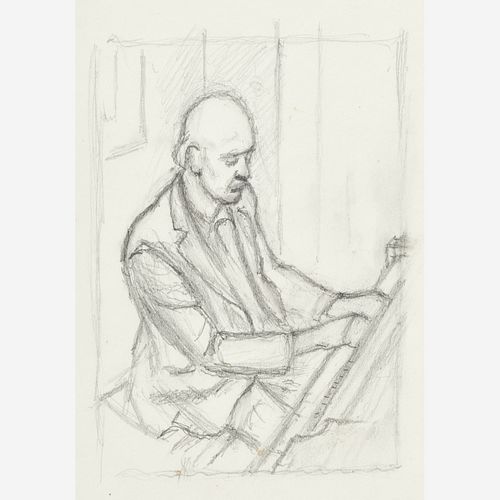Thomas Hart Benton "Man Playing Piano" Graphite (ca. 1948)
Bid Increments
| Price | Bid Increment |
|---|---|
| $0 | $25 |
| $500 | $50 |
| $1,000 | $100 |
| $5,000 | $250 |
| $10,000 | $500 |
| $20,000 | $1,000 |
| $50,000 | $2,500 |
| $75,000 | $5,000 |
| $100,000 | $10,000 |
Thomas Hart Benton
(Missouri, 1889-1975)
Man Playing Piano, circa 1948
Graphite on paper
6" x 4 1/4" (image)
Benton scholar Dr. Henry Adams: "Benton took up music in 1930, during in a period of emotional let-down after completing his America Today mural. One evening a dentist friend, M. A. Jagendorf, came over from dinner and played a tune on his son’s harmonica. Benton was entranced and determined that he would learn to play the instrument. He bought a book on music for about ten cents and in roughly six months had learned to pick out quite complicated lines. Shortly afterward, he organized a harmonica ensemble with his students and they played regularly on Saturday nights. “This was hard on the neighbors,” Benton later recalled, for we sounded like a catfight most of the time, but it was so much fun that we kept going in spite of all protests.” During this period, Benton devised a new method of musical notation for the harmonica which was easier for beginners to read than the traditional system. He never bothered to patent it. Rather than indicating notes on a staff, it would provide the number of the holes one should blow through, with an arrow indicating whether to blow in or out. The system is still used by commercial music publishers.
"During this period Benton began to socialize with notable composers, such as Henry Cowell and Carl Ruggles, as well as with pioneer collectors of American folk music, such as Charles Seeger. He also began to carry a harmonica when he went on his sketching trips and to get country fiddlers and singers to teach him their tunes.
"After he moved to Kansas City, Benton revived his music group and began holding musicals with members of the Kansas City Symphony. He also socialized with musicians on Martha’s Vineyard, where his friend Ed Robinson, a professional musician, wrote the Chilmark Suite for him, to be performed by the combination of harmonica and recorder. These musical activities culminated in a professional record, Saturday Night at Tom Benton’s, which was released by Decca in 1942.
"This sketch clearly portrays one of Bentons’ musical friends and most likely dates from the 1940s. On Martha’s Vineyard, Benton was friendly with two members of the Mannes family, David and his son Leopold. David, a violinist, was concertmaster of the New York Symphony, conducted by the legendary Walter Damrosch, and founder of the Mannes School of Music in New York. Leopold, a pianist, succeeded his father as president of the school and transformed it into a college of music. Under his leadership, distinguished musicians such as George Szell, Georges Enesco, and Bohuslav Martinu taught there. This sketch may possibly represent David Mannes, whom Benton portrayed in his painting Evening Concert of 1948."
Housed in a glazed frame measuring 17 3/4" x 13 3/4".
Condition
Good condition, noting a few small spots of spatter at the bottom of the image and in the bottom margin.
Available payment options
Pick Up, Packing, & Shipping: Winning bidders may pick up their lots, once paid in full, at Circle’s auction office during regular business hours. If packing and shipping is required, we can provide you with a list of recommended shippers by request. You will be responsible to contact, arrange shipment, and pay 3rd party shippers. Circle will not be responsible for loss or damage of purchased lots handled or shipped, nor for acts and omissions, by 3rd party shippers, whether recommended by us or not. Circle will not release the lot for shipment until payment has been made in full and a buyer’s written shipping authorization form has been received. Winning bids may not be retracted, canceled or rescinded due to issues with shipping including, but not limited to, costs or prohibitions. It is the responsibility of the bidder to account for shipping prior to bidding. Failure to Pick Up & Storage: Winning bidders must pick up or have lots shipped within 15 calendar days of the close of the auction. On the 16th day from the close of the auction Circle has the right to charge the winning bidder a storage fee of $5 per lot per day. Lots that have been paid for, but remain on our premises sixty (60) days from the close of the auction may be sold by Circle, with no notice to the buyer. Any funds in excess of the purchase price, commissions, applicable costs, and storage fees will be remitted to the original winning bidder. At the point where storage fees associated with an unshipped item exceed the hammer price of the item the winning bidder will be considered in default of our terms and conditions and forfeits ownership to Circle Auction or its affiliated companies. In the case where the item is forfeited the winning bidder will not be compensated in any way. Lots left with Circle after the 16th day from the close of the auction are stored at the buyer’s risk. If you have any questions regarding these terms please contact Circle Auction by email at : Info@Circle-Auction.com
Acquired by Vincent and Leah Campanella directly from Thomas and Rita Benton over the course of their 25 year friendship. A portion of the collection was given to the Campanellas by Rita in 1975 as compensation for Vincent completing "The Sources of Country Music," the mural left unfinished when Tom passed away in 1975. Vincent Campanella was later prominently featured in the Ken Burns documentary Thomas Hart Benton (1988). In 2001, the Campanella family sold the collection to the current owner, a private Kansas City collector.
Benton scholar and author, Dr. Henry Adams, has authenticated the entire collection in person. You can find his essay documenting the 25 year tumultuous friendship of Vincent and Thomas and the origins of the collection at Circle-Auction.com. A copy of his essay will be provided to all winning bidders.













